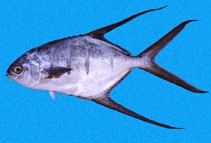| Family: |
Carangidae (Jacks and pompanos), subfamily: Trachinotinae |
| Max. size: |
61 cm TL (male/unsexed); max.weight: 1,300.0 g |
| Environment: |
reef-associated; marine |
| Distribution: |
Eastern Pacific: Zuma Beach in southern California, USA to Peru, including the Galapagos Islands. |
| Diagnosis: |
Body deep (becoming deeper with age) and compressed; mouth small; jaw teeth small, villiform, and only slightly hooked; decreasing in number with age but always present; lower branch of first gill arch with 13 to 15 gill rakers; dorsal fin with 6 spines followed by another spine and 19 to 21 soft rays (VI+I, 19-21); anterior lobes of the second dorsal and anal fins elongated; body silvery with 4 to 6 pale yellow vertical bars that become dark after death; dorsal, anal, and caudal fins yellowish (Ref. 55763). |
| Biology: |
Adults inhabit inshore sandy areas and also clear waters around reefs and rocky areas (Ref. 9283). They feed on small invertebrates and fishes (Ref. 9283). Marketed fresh and salted or dried (Ref. 9283). |
| IUCN Red List Status: |
Least Concern (LC); Date assessed: 04 February 2009 Ref. (130435)
|
| Threat to humans: |
harmless |
Source and more info: www.fishbase.org. For personal, classroom, and other internal use only. Not for publication.

